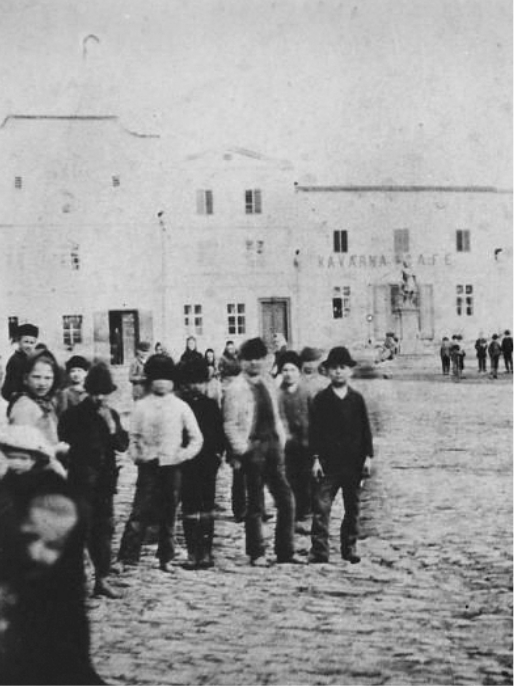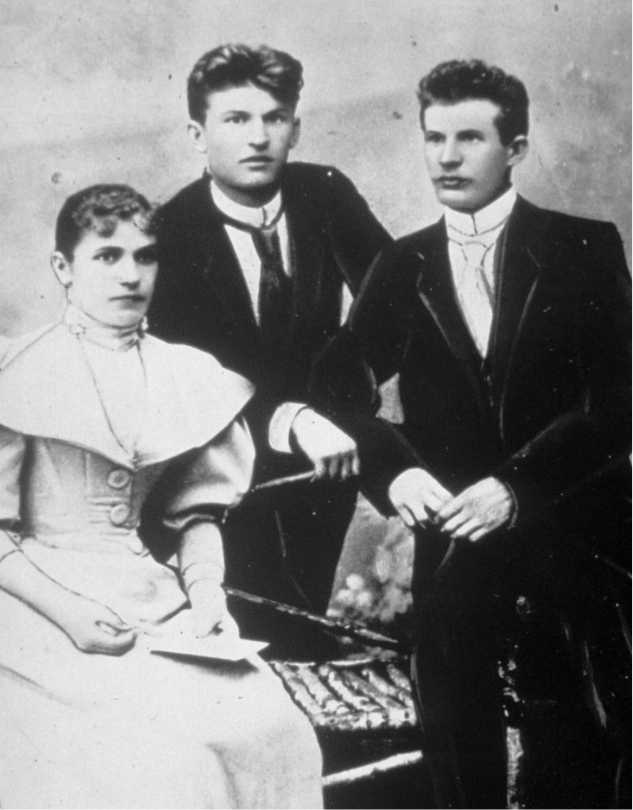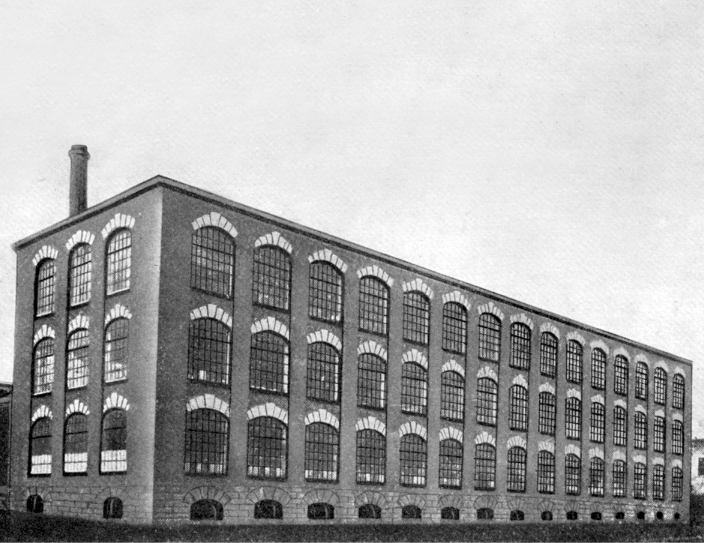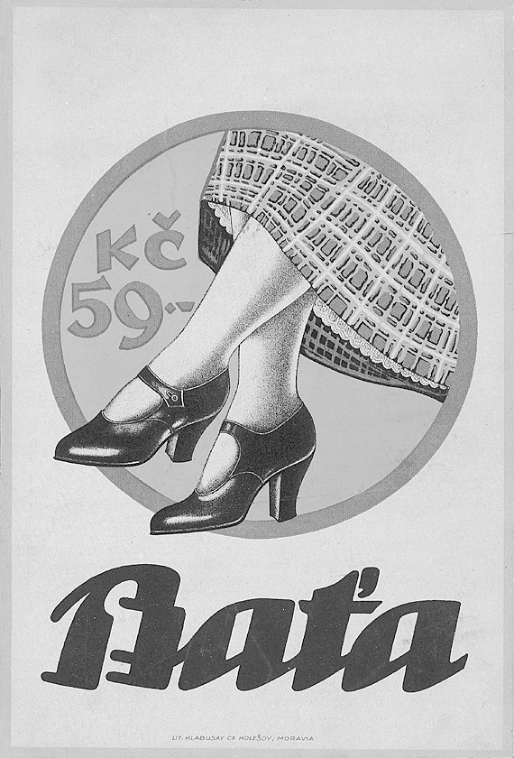
Tomas Bata was born in Zlin to a shoemaking family as a member of the seventh generation of families of local craftsmen-shoemakers; Tomas’s direct ancestor Lukas Bata is mentioned in 1667 as a shoemaker in Zlin
With the declaration of his father, Tomas and his older brother Antonin became adults, so that Tomas could start working as a business traveler and win contracts for his father’s workshop in Prague and elsewhere
As a fifteen-year-old, Tomas started to produce fleece shoes on his own in a workshop in Vienna- Döbling, however, this attempt soon failed

Antonin Bata obtained a trade license authorizing the production of footwear in Zlin; the family business was founded by his older sister Anna and younger brother Tomas, all of whom together made a capital of about 800 gulden; from its first address on Dlouha Street, the workshop soon moved to a house in the Zlin Square
After a year of business, the Bata sibling plant had more than 8,000 gulden debt and was facing bankruptcy, and at the same time Antonin went to war – so in October of that year Tomas himself remained in charge of the company – it took him about a year to avert bankruptcy, the company had 50 employees

The company launched light textile shoes called “BATOVKY”, their success with customers guaranteed the prosperity and growth of the company
Anna Bata left the company after her marriage. She became Anna Schieblova and was paid out her share; Antonin and Tomas remained as business partners of the company
On his way to Frankfurt, Germany, Tomas came to know the machinery for the production of footwear; he brought several simple machines to Zlin to improve production
Tomas’s and Antonin’s joint company was logged in the Commercial Register under the name T. & A. Bata, headed by Tomas; their first building was built near the Zlin railway station – and thus the construction of Bata factory complex began – the company had about 120 employees
A new field of business – a locksmith’s workshop became the basis of Bata’s engineering works. Brothers Tomas and Antonin attended the founding meeting of the Zlin organization of the Social Democratic trade unions
From January to May, Tomas lived in the USA and gained experience in the local shoe factories – he became acquainted with the American style of business and way of life; after returning to Europe, he visited factories in England and Germany

Using American inspirations, Tomas had a modern three-storey red brick factory building built – the company was paralyzed by a several-month strike by workers, and Bata halted the union activity within the company
After the death of his brother Antonin, Tomas remained the sole owner of the T. & A. Bata company
The company’s premises expanded with the purchase of the neighboring defunct Lehr factory – a new line of business – the printing house
A kitchen with a dining room was set up for employees
Tomas Bata married Marie Mencikova, the daughter of the custodian of the Imperial Court Library in Vienna – the villa of Tomas Bata was completed according to the project of the Prague architect Jan Kotera; construction of residential houses for employees began
Bata’s shoes were exported abroad (Germany)
Thomas Bata junior was born; the company had 400 employees and was one of the major footwear manufacturers in the country; after the outbreak of war, Bata company won extensive government contracts for military footwear and expanded production
New fields of business – tanning, electrical engineering
New branch of business – retail
A Bata’s factory branch was established in Pardubice (it was in operation in the years 1917-1923) – new fields of business – agriculture, domestic shoe stores
Bata employed 4,000 workers; characteristics could be compared to American companies (F. Obrtel – America in Zlin) appeared to the public – new fields of business – forestry, building materials, newspaper publishing – employees could use services such as kindergarten and library, and improved training courses began for them
Tomas Bata stayed in the USA and got to know the companies of the automotive (Ford) and footwear (Endicot- Johnson) industries, during this stay he established his own factory in Lynn (it was in operation in 1919-1921) – new fields of business – wood processing, foreign shoe stores, company savings bank

New field of business – advertising – the company had 2,210 employees
Free visits to the cinema for employees, the company orchestra was established
With the establishment of sister companies, Bata expanded its business to the Netherlands, Yugoslavia, Poland, Denmark, England – and in the following years also to many other countries
In order to overcome the crisis, Tomas Bata cut prices in half – he gained customers, dominated the Czechoslovak footwear market, started a new stage of company growth
Tomas Bata was elected mayor of the city of Zlin, then he held the position in the years 1923-1932 – a new field of business – shoe repair
Self-governing workshops were introduced into the organizational structure of the company and participation in profit and loss was introduced to strengthen motivation – these methods significantly increased production and economic results (“I was looking for a way that would work automatically as sunrise and sunset” – T. Bata); a research department was set up to support inventions and technical development
New fields of business – rubber, construction, rail transport, air transport (company airport in Zlin)
A company health and social department was set up; the factory complex began to be built according to the project “Factory in the Gardens” by architect Frantisek L. Gahura; a corporate Sports Club (SK Bata) was established to support sports; for the first time, Tomas Bata organized public celebrations on May Day
Development of Bata’s methods of organization and economics of business – technological rationalization was completed in 1927 by installing moving belts for the production of footwear
In search of new markets, Tomas Bata makes his first trip to India; when hiring employees, a psychotechnical laboratory began to operate
A new field of business – building design
Vocational education began to be provided by the company’s apprenticeship school – Bata’s school of work (Young Men, later also Young Women); Tomas Bata, as the mayor of the city, started the reform of public education in Zlin
Tomas Bata’s last trip to the USA
New fields of business – chemical production, paper processing, road freight transport, book publishing, cinema
Employment of disabled people (work in cardboard)
The concept of modern Zlin as a garden city was published by mayor Tomas Bata and architect Frantisek L. Gahura

New fields of business – food processing, filmmaking
The Bata Hospital in Zlin began operating
Bata accounted for 55% of Czechoslovak footwear exports; Czechoslovakia achieved first position globally in leather footwear exports; Tomas Bata announced the intention to build a railway connection Prague – Ceska Trebova – Kromeriz – Zlin – Puchov – Kosice
A new field – chemical research
Social care gained a base in the newly established Bata support fund; Tomas Bata contributed to the development of scientific research with significant financial support for the Anthropos pavilion in Brno
A new company airport was established in Otrokovice with the intention of introducing an international air connection there; the subsequent construction of Bata’s companies in Otrokovice formed a wider industrial agglomeration Zlin-Otrokovice; Tomas Bata published a proposal for the organization of the finances of the Moravian-Silesian country and offered to provide three thousand telephones to Moravian municipalities and schools
A new field of business – pedicure
Experimental schooling methods began to be applied in Zlin schools
The company’s production facilities were transferred to a five-day working week (45 hours); Tomas Bata published the intention to modify water management on the Morava River and the vision of connecting the rivers Elbe, Danube and Odra
A new field of business – insurance
A company footwear museum was opened, a zoo was established near Zlin Castle; the Zlin experimental schools took over the publishing of the pedagogical magazine “Creative School”; vocational secondary education – with the opening of evening courses at the Uherske Hradiste Business Academy in 1930, the formation of the Zlin Business Academy began (opened in 1937)
The company T. & A. Bata was transformed into a joint stock company – Bata Ltd., Zlin; Tomas Bata founded in St. Moritz Leader AG with a capital connection with the foreign network of its companies; Bata’s concern expanded to include leather factories in Trebic, Bosany and Nove Zamky, and a new shoe factory was built in Ottmuth (Germany); Tomas Bata proposed to the Prime Minister the program of regional development of Central and Eastern Moravia
New fields of business – textile production, gas industry
Together with the construction of factories and housing estates began the export of Bata’s Zlin architecture to many countries
Tomas Bata built new shoe factories in Borovo (Yugoslavia), Chelmek (Poland), Möhlin (Switzerland), Hellocourt (France), factories in Tilbury (England) and Konagar (India) are being prepared
New fields of business – car tires, coal mines, sea shipping, hotel
Tomas Bata died in a plane crash in Otrokovice
His company had over 31,000 employees and had savings of CZK 152,000,000 in personal accounts
Bata did business in 36 fields of production, trade and services
The assets of Bata Ltd., Zlin as at 31 December 1931 amounted to CZK 920 million and were 80% covered by equity (share capital 175 million, reserve funds 515 million, retained earnings 46 million)
The annual production was 36,300,000 pairs of shoes; Bata provided 81% of footwear production and 75% of exports in the Czechoslovak Republic.
The group produced in Czechoslovakia (Zlín, Otrokovice, Trebic, Bosany, Nove Zamky, Krasice ) and also in new factories in Germany, Yugoslavia, Poland, Switzerland, France (others were built in England and India)
Bata’s world trade network included 2,500 stores (1,800 in Czechoslovakia, 700 abroad). Bata’s sister companies operated on four continents in 24 countries.
In July 1932, the management of the world company Tomas Bata was taken over by a three-member team consisting of Jan Antonin Bata, Dominik Cipera, Hugo Vavrecka
Dominik Cipera (1932-1945) took over the function of the mayor of Zlin
New footwear production Beirut (Syria/ Lebanon) began professional (high school) engineering studies and developed into a corporate high school institute – multidisciplinary Industrial School (opened in 1937)
New Best factory (Netherlands), Batanagar (India) and Baghdad factory (Iraq) were established;
A 40-hour working week of new fields of business was introduced – aircraft production, rubber plantations
New factories were established in Napajedla and Batizovce
New field of business – production of man-made fibers in Zlin started the operation of the company
Study Institute with educational and research programs
The company produced over 58,000,000 pairs of shoes
New field of business – export wholesale
The organization of the I. Zlin Salon created a tradition of fine art shows
New factories were established in Batavia (Dutch India), Singapore, Vernon (France)
Within Zlin the operation of the company Industrial School began
Bata had 65,000 employees (42,000 in Czechoslovakia, 23,000 abroad); a member of the company’s management Hugo Vavrecka held the office of Minister of the Czechoslovak Government (September-November 1938); Dominik Cipera, a member of the company’s management, became Minister of Public Works of the Czech-Slovak Government (December 1938)
New factory in Liptovsky Mikulas
New business branch – river transport (Bata canal)
In Zlin started a higher vocational education institute – Tomasov – as a school for corporate managers (1938-1940)
The company Bata did business in 42 fields of production, trade, services; factories and sister companies in 39 countries; its worldwide sales network included 5,500 shoe stores; After the German occupation of the company’s management in Zlin formed a management team composed of: Dominik Cipera, Hugo Vavrecka, Josef Hlavnicka, the impact on the management of the German occupation authorities forced
The new factory Simonovany -Batovany (Partizanske), Zruc nad Sazavou, Sezimovo Usti; other factories in Europe, Africa and America; A new field of business – spa (Bojnice)
In Zlin started the activity of a higher vocational education institute – School of Arts (today Secondary School of Applied Arts in Uherske Hradiste)
Thomas Bata junior went into exile in March 1939, then landed in Canada and built a factory there in Batawa; Jan Antonin Bata went into exile in June 1939 and then, when he was forced to leave the USA in 1941, he settled in Brazil in the newly founded Batatuba; Jan A. Bata lost influence over the management of the company and since 1941 the work of Thomas Bata junior has been growing in this direction
The Zlin management, led by D. Cipera and H. Vavrecka, managed Bata companies in continental Europe with 85,000 employees; other Bata societies were in the British Empire, the American continent, Africa and Asia

During the war against Germany and Japan, 235 Bata employees fought in the Allied armies; Mary Bata was present in Zlin and together with her the company’s management contributed to activities against the German occupiers – among other things by supporting fighters in the Slovak National Uprising and by supporting guerrillas in Eastern Moravia; Thomas Bata junior cooperated with the Czechoslovak resistance of the government of exile E. Benes in London
Bata enterprises in Czechoslovakia were nationalized, similarly after the war Bata enterprises in other countries of Central Europe and the Balkans were nationalized;
For the management of Bata companies in Western Europe and overseas, Thomas Bata junior founded a new company Bata Development Limited and its headquarters were situated in London
Almost three quarters of Bata’s companies were lost through nationalization interventions in Central and South-Eastern Europe, 38 factories and 2,168 stores remained in Bata’s Western organization, 34,000,000 pairs of shoes were produced, the company had 34,000 employees
Representatives of the Bata company were brought to justice in Prague and Dominik Cipera was released; In a politically constructed trial, Jan Antonin Bata was unjustly convicted of refusing to openly join the Czechoslovak war resistance;
lawsuits have been initiated between Thomas Bata junior and Jan Antonin over the Swiss company Leader A. G., statements by US courts in the years 1950-1960 confirmed the ownership of Thomas Bata junior
Representatives of Bata’s plants – Dominik Cipera, Hugo Vavrecka and Frantisek Malota – were convicted in a politically constructed trial at a court in Uherske Hradiste
Under the leadership of Thomas Bata junior, business expanded around the world – in new factories in the USA, Mexico, Brazil, Algeria, Sudan, Tanzania , South Africa, Vietnam, India, Sri Lanka, etc.
Bata’s production and sales activities operate in 79 countries around the world: 66 factories, 4,100 stores, annual production of 175 million pairs of shoes
Thomas Bata junior moved the headquarters of the family company Bata Shoe Organization from London to Toronto, Canada
The company’s business expanded in Latin America, Africa and Asia: new Bata plants were added to older companies in Chile, India and Pakistan, new factories began operating in Nigeria, Congo, Uganda, Upper Volta, Niger
Bata’s shoe organization had 98 companies with 90,000 employees in 89 countries, 250,000,000 pairs of shoes were produced in 90 factories, 290,000,000 pairs of shoes were sold in 5,000 stores

The Bata Shoe Museum was founded in Toronto
Thomas Bata junior worked in the group of UN expert advisers at the Commission for Multinational Corporations
Thomas Bata junior resumes business in Czechoslovakia: as part of a major privatization, he bought a network of stores and set up a company based in Zlin (it includes a network of stores and a factory in Dolni Nemci)
The renovated Tomas Bata Villa is inaugurated and the newly established Thomas Bata Foundation begins operations
A university was established in Zlin named after Tomas Bata, the company’s founder
Son Thomas George Bata took over the management of the company from Thomas Bata junior, the headquarters of the organization became Lausanne in Switzerland
Thomas Bata junior died